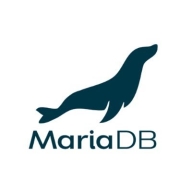

MariaDB and ClickHouse compete in the database management sector. ClickHouse appears to have the upper hand due to its superior real-time query processing and scalability, especially for big data applications.
Features: MariaDB offers comprehensive integration options and is renowned for stability in high-availability environments. It integrates well with various systems and provides excellent replication modes, making it compatible with MySQL. ClickHouse is optimized for big data analytics with real-time query processing, superior scalability, and strong data compression capabilities, distinguishing it for efficiently handling large datasets.
Room for Improvement: MariaDB needs to enhance its integration, clustering, and replication capabilities as some users note concerns in these areas. Its scalability and setup complexity also require attention. ClickHouse should focus on improving third-party integration and addressing deployment complexities, particularly in cloud environments. Enhancements in SQL compatibility and traditional database features like triggers could broaden its appeal.
Ease of Deployment and Customer Service: MariaDB is valued for its flexibility in deploying across on-premises, hybrid, and cloud environments, with sufficient community support available. ClickHouse offers efficient on-premises and hybrid deployment but could improve documentation and specialized support. Open-source nature leads to varied support experiences for both solutions.
Pricing and ROI: Both MariaDB and ClickHouse are largely open-source, providing cost-effective implementation. MariaDB's community version helps avoid Oracle licenses, resulting in significant savings. ClickHouse offers affordability and cost-effective scalability, particularly when self-hosted, making it suitable for substantial workloads. Both solutions provide substantial ROI by reducing licensing costs and enhancing operational efficiency.


ClickHouse is renowned for its speed, scalability, and real-time query performance. Its compatibility with SQL standards enhances flexibility while enabling integration with popular tools.
ClickHouse leverages a column-based architecture for efficient data compression and real-time analytics. It seamlessly integrates with tools like Kafka and Tableau and is effective in handling large datasets due to its cost-efficient aggregation capabilities. With robust data deduplication and strong community backing, users can access comprehensive documentation and up-to-date functionality. However, improvements in third-party integration, cloud deployment, and handling of SQL syntax differences are noted, impacting ease-of-use and migration from other databases.
What features make ClickHouse outstanding?ClickHouse is deployed in sectors like telecommunications for passive monitoring and is beneficial for data analytics, logging Clickstream data, and as an ETL engine. Organizations harness it for machine learning applications when combined with GPT. With the ability to be installed independently, it's an attractive option for avoiding cloud service costs.
MariaDB is an open source relational database created by the original founders of MySQL. It is considered one of the most popular and trusted database servers throughout the world. MariaDB is a valued component found in most cloud offerings and is the default in many Linux tools. It is also widely used by Wikipedia, WordPress, and Google, among other well-known sites. Maria DB easily melds data into concise information from a vast array of applications, such as banking, online shopping, websites, and more.
MariaDB was originally created to improve MySQL performance. It is the most widely chosen database server due to the solution being super fast, robust, user-friendly, and easily scalable. MariaDB also offers a substantial ecosystem of plugins, storage engines, and numerous other valuable tools that make it very attractive for a significant offering of use cases.
The solution’s newest functionalities include compatibility with Oracle Database and Temporal Data Tables, and advanced clustering with Galera Cluster 4, which make it easier for users to research data history from any point in the past. Additionally, the most recent versions include JSON and GIS features. MariaDB is committed to staying an open source solution.
MariaDB Features
Reviews from Real Users
Faustine C., Engineering Supervisor- Corporate Data Solutions and Services at TZ Telecoms Corporation, shares, “The software provides a lot of information on what is happening inside the database. For most performance parameters it is easy to know if something is not right in the configuration or optimization which helps engineers take remedial fine-tuning measures. For example, if the database is underperforming it is easy to know which performance parameter can be adjusted to handle the workload. It is difficult to troubleshoot database issues if many performance parameters can not be monitored or debugged which is the case with some database management systems. It provides great monitoring of data storage, processing, and performance stability which is really important for real-time data storage and processing. It's a user-friendly product.”
A PeerSpot user who is a Senior Engineer at a tech services company relates, “ The solution's high availability is its most valuable aspect. We have found the product to be stable and the initial setup is pretty simple. I'd rate the solution at a ten out of ten. I'm very happy with it overall. I would recommend the solution to others. It's easy to find details about the product online and to learn about it.”
We monitor all Open Source Databases reviews to prevent fraudulent reviews and keep review quality high. We do not post reviews by company employees or direct competitors. We validate each review for authenticity via cross-reference with LinkedIn, and personal follow-up with the reviewer when necessary.